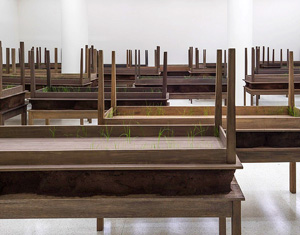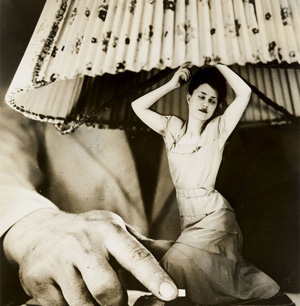The Best in Failure
John Haberin New York City
Hype and Fear: 2015 in Review
Every year, I say that I will avoid a ten-best list. And once again, I cannot resist looking back.
Listicles annoy me anyway, but they also go against my whole idea of criticism. I want to draw you into art not by telling you who is naughty and nice, but by describing it and teasing it out. So how about this year I tease you instead with failure? 
1. Best show I failed to review
I can fool myself into thinking that I can cover it all, but sometimes I never find the words. And hands down, this one goes to Alma Thomas in Chelsea. She may not have pushed painting to its limits, but she pushes a brush against canvas repeatedly, for her signature compositions. They stand uniquely between the open spaces of Joan Mitchell and the grids of Minimalism.
The year derived much of its punch from black artists, too, many just as exhilarating. Forget the pandering and ego-tripping and of Kehinde Wiley in Brooklyn. Start instead with a show questioning what counts as black or white art at the very same gallery as Thomas. Other highlights include the entirety of Jacob Lawrence's The Migration Series, together again at MoMA. They include, too, Lorraine O'Grady and Charles Gaines at the Studio Museum in Harlem, Gordon Parks on the Lower East Side, geometric abstraction by Stanley Whitney and Odili Donald Odita, and Archibald Motley as the very first loan show at the new Whitney Museum. And there is more to Thomas than repeated brush marks.
Runner-up might well go to another African American, for I have not made it to Philadelphia for Normal Lewis, at least yet. At least he had his due alongside Lee Krasner, at the Jewish Museum just this last winter. Somehow I also failed to mention Roland Flexner on the Lower East Side. A pairing with bronzes from Edo period Japan proved insightful, but Flexner's small studies in ink stand alone as fluid spaces with the rigor of black on black and the delicacy of a bubble.
2. Best uglification project
Again, a no-brainer, the new Whitney Museum by Renzo Piano. The building that everyone loved to hate finally opened, with an eye-opener.
Of course, critics are take in by the splash of a new museum as much as anyone. They gushed over MoMA in 2004, for all its lost mission and wasted space, and the New Museum on the Bowery, for all its unsuitability for the display of art. And make no mistake: the Whitney still looks institutional and oppressive from the outside, especially from the north. I still miss the Whitney's former home on Madison Avenue, soon to be the Met Breuer.
 Yet it quickly fit in with its neighbors—and crowds have embraced it. It also nestles nicely into the High Line, thanks in part to terraces for sculpture. And that initial impact looks likely to last, thanks to spacious but flexible galleries. Already they have enhanced a small retrospective for Motley and a huge one for Frank Stella, following a museum-wide display of the permanent collection.
Yet it quickly fit in with its neighbors—and crowds have embraced it. It also nestles nicely into the High Line, thanks in part to terraces for sculpture. And that initial impact looks likely to last, thanks to spacious but flexible galleries. Already they have enhanced a small retrospective for Motley and a huge one for Frank Stella, following a museum-wide display of the permanent collection.
For a runner-up how about instead the worst beautification project? I mean the relentless march north of the High Line, along with its relentless march of tourists. Jerry Saltz takes it as emblematic of the decline of public spaces for art into private enclaves, and a cultural center in Hudson Yards still to come could well prove him right. Just bear in mind that art is often private property, like the Whitney, and it survives.
3. Most overblown fear
This one is also the most over-reported news, because it is news that the public can readily envy and understand. I mean auction prices and pricey galleries to match.
Oh, go ahead: be afraid of celebrity artists. Be very afraid. A popular webzine went for year's end clickbait by naming Jeff Koons, Ai Weiwei, and Damien Hirst among the most influential living artists, as if everyone else were making balloon dogs and date paintings—or as if anyone still cared about Hirst. Yet the fearful can easily miss almost the entire art scene. They can also miss more deadly reasons to fear.
For top reasons to fear art and money, there are all too many winners. And they all come down to the pressures on ordinary artists and dealers to survive. With well over a hundred galleries, can the Lower East Side still offer an alternative? Yes, the year had its tens of millions, but also its perpetual art fairs, the suspect role of art advisors, and worst of all rising rents. Not coincidentally, the Museum of Biblical Art closed its doors after a show of Donatello and Renaissance Florence. The year's best show of art history, with Andrea del Sarto at the Frick a runner-up, was the museum's last.
4. Most overhyped trend
A tough call, in a scene dependent on hype and trends. Still, I vote for zombie formalism.
Sure, the phrase is a keeper—and its epitome in "The Forever Now" at MoMA was shallow, slick, and pretentious. Yet the very same critics making the charge went crazy for abstraction's leading zombie, Albert Oehlen at the New Museum. Nor has a previous hype, installation art, gone away. Come to think of it, Yoko Ono in retrospective and in Chelsea looked pretty darn good. Photography and tapestry also had a good year.
More to the point, so did abstraction. One can hardly have zombie painting unless painting is dead. Now that anything goes, it does have to share space with other genres and other media, often on the same canvas.  Still, the year's stunning examples include Whitney and Odita, Jackie Saccoccio and Stephen Maine, Michael Goldberg and Gary Petersen, Valerie Jaudon and Don Voisine, and many more. As a runner-up, emerging artists are often overhyped and always a trend. And the New Museum Triennial and Greater New York blew it.
Still, the year's stunning examples include Whitney and Odita, Jackie Saccoccio and Stephen Maine, Michael Goldberg and Gary Petersen, Valerie Jaudon and Don Voisine, and many more. As a runner-up, emerging artists are often overhyped and always a trend. And the New Museum Triennial and Greater New York blew it.
5. Best politically correct art
This year art of the Americas kept coming, and it earned the attention. I have real qualms about a much praised runner-up, Martin Wong at the Bronx Museum, but he deserved a look back, too.
MoMA had a running theme of an exchange between Europe and Latin America—with the contemporary art in "Transmissions," the architecture in "Latin America in Construction," and the photography of Grete Stern and Horacio Coppola. Less convincingly, Francisco Oller at the Brooklyn Museum traveled between the Caribbean and Impressionism, without quite settling on either one.
Yet the real winner was Doris Salcedo at the Guggenheim. Speaking of a year of failure, her Post-Minimalism turns out to have layers of fraught political and emotional history. It also bridges the everyday, of office furniture and grass, with the stunning rarity of a carpet of rose petals. They convey memories of Colombia as both a vivid presence and an inescapable loss. Salcedo could also win for the best discovery of an artist in front of one's eyes all along, along with Picasso sculpture at MoMA. They were, for me, the two finest shows of 2015.
Happy new year!

Alma Thomas ran at Michael Rosenfeld through May 16, 2015, Roland Flexner at Sargent's Daughters through October 11. Of course, this site has reviewed pretty much all this and more at length. You can now also see year-end reviews for 2007, 2008, 2009, 2010, 2011, 2012, 2014, 2015, 2016, 2017, 2018, 2019, 2020, 2021, 2022, and 2023.




